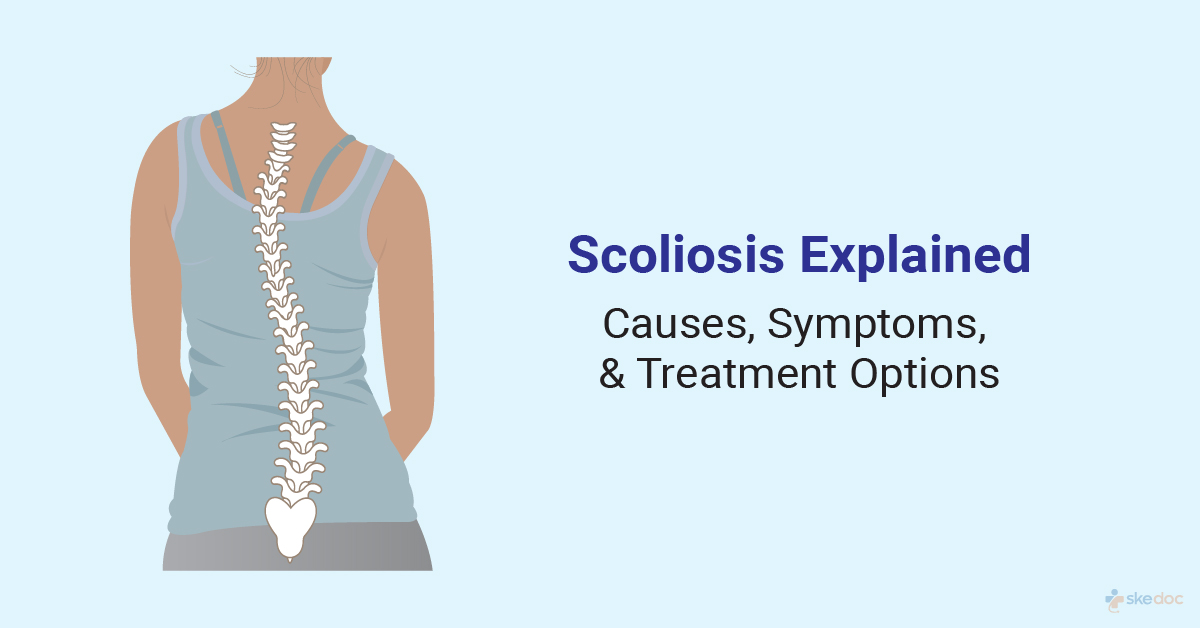Allergy
Blood Diseases
Bone & Joints
Brain
Cancer
Child Care
Cosmetic Surgery
Diabetes
Endocrinology
ENT
Eye
Gen Medicine
General Surgery
Heart
Kidney
Lifestyle
Liver & Digestive
Lung
Men’s Health
Mental health
Physiotherapy
Rheumatology
Skin and hair
Sleep Disorders
Spine
Transplant
Women Health
Thyroid
Vascular Surgery
What are the Symptoms and Causes of Scoliosis

What is Scoliosis?
Scoliosis is an abnormal and sideways spine curvature with the deformity extending in all 3 dimensions. Scoliosis may be secondary to other medical conditions affecting the brain and muscles or may have no identifiable cause. The effects of the deformity on day-to-day lives depend on the severity of the condition.
Is a scoliosis condition a Medical emergency?
Scoliosis is not a medical emergency.
Types of Scoliosis
Scoliosis may be of the following types:
- Idiopathic Scoliosis: There is no known identifiable cause
- Infantile Idiopathic Scoliosis: Identified in children below the age of 3 years
- Juvenile Idiopathic Scoliosis: Identified in children aged 3-10 years
- Adolescent Idiopathic Scoliosis: Identified in children more than 10 years
- Neuromuscular Scoliosis: May be associated with neuromuscular dysfunction
Causes
The exact cause of Scoliosis is not fully understood, but genetic and environmental factors are believed to play a role in its development.
Some conditions that may result from its development include:
- Cerebral palsy
- Muscular dystrophy
- Syringomyelia
- Spinal cord trauma
- Polio myelitis
- Spinal muscular atrophy
- Arthrogryposis
- Myotonia
It may be seen in association with other syndromes, such as:
- Marfan’s syndrome
- Charcot Marie tooth disease
- Ehler danlos syndrome
- Osteogenesis imperfecta
Risk factors
Factors that increase the risk of Scoliosis include:
- Gender: Slightly more common in girls
- Age: Usually seen during adolescence
- Family history of the condition
Signs & Symptoms
The signs and symptoms associated with Scoliosis may include:
- Asymmetry of the shoulders, ribcage, or the waist
- Pain in the back or neck
- Prominent shoulder blade on one side
- Uneven arm or leg length
- Less muscle mass on one side of the spine
- Symptoms that are seen in severe forms of the disease may include:
- Constipation
- Breathing problems
- Limited mobility
Investigations
Some investigations that are advised for the evaluation of the condition include:
- Laboratory tests:
- CBP & ESR
- Coagulation profile and blood typing
- Liver and renal function tests
- Serum electrolytes
- Iron profile
- Imaging tests:
- Radiography – of the spine
- MRI of the spine and brain
- Ultrasound
- Pulmonary function testing
- Complete neurological examination
Diagnosis
A diagnosis of Scoliosis is established based on medical history, clinical evaluation, and results of the investigations done.
Treatment Options
The treatment for Scoliosis depends on the type and severity of the condition. Individuals with mild Scoliosis are managed with regular watchful waiting to monitor for any changes or progress in the condition. Treatment usually combines monitoring, bracing, and surgical interventions as and when required. In general, gender, the severity of the curve, the type of curve, the curve's location, and the child's age are considered when deciding on the appropriate treatment.
Medical management
Medical management may include:
- Analgesics: For the management of pain
Interventional including surgery and indications for surgery
Surgical interventions are done under the following conditions based on the type of condition that is present as follows:
- Infantile idiopathic Scoliosis: Surgery is done when bracing is not able to correct deformities that are more than 250
- Juvenile idiopathic Scoliosis: Surgical interventions are done for flexible curves of more than 400 and any curve of more than 500
- Adolescent idiopathic Scoliosis: Surgical interventions are done for curves of more than 300
- Neuromuscular Scoliosis: Antero-posterior or posterior spinal fusion with rigid or non-rigid fixation is done
Role of Diet/ Exercise/ Lifestyle changes/ Preventive
The following measures may help with the management of the condition:
- Bracing: It is done in children with moderate Scoliosis. It is done to help with the prevention of the progression of the disease. Bracing is continued until the bones stop growing, and they are worn continuously throughout the day and night
- Infantile idiopathic Scoliosis: Bracing is done when the angle is less than 250
- Juvenile idiopathic Scoliosis: Bracing is done when the angle is less than 400
- Custom molded thoracolumbar orthosis: It is used in the management of neuromuscular Scoliosis to help with normal spinal growth
- Molded seating supports: To help with the management of neuromuscular Scoliosis to help with normal spinal growth
- Physical therapy: To help with overall wellbeing and health
Complications
Some complications associated with this condition include:
- Respiratory problems
- Chronic back pain
- Hip dislocation
- Cardiovascular disease
- Low self-esteem
- Depression
- Complications of surgery:
- Infections
- Failure of fusion
Prognosis
The prognosis depends on the type and severity of the condition and the degree of curvature. The milder forms of the condition have a better prognosis, and those conditions that are identified early and managed well without any postoperative complications have a better prognosis and long-term outlook.
When to contact the doctor or hospital?/ How to identify the emergency or complications?
It is advisable to seek medical attention if any deformity is observed in the spine's structure in children or adolescents.
Indications for hospitalization if required
Hospitalization will be required if surgical interventions are advised.
Suggested clinical specialist/ Departments to consult for this condition
- Orthopaedics
Was this article helpful?
YesNo




